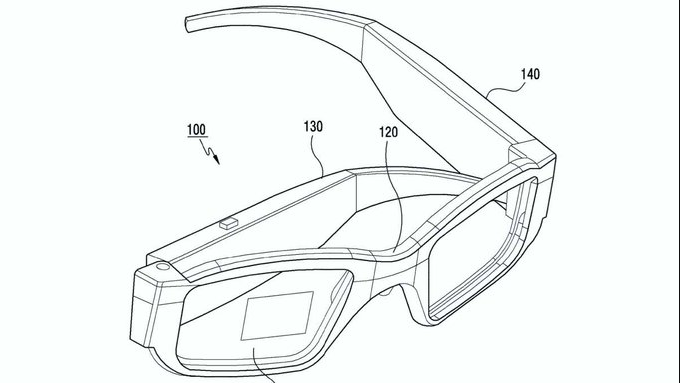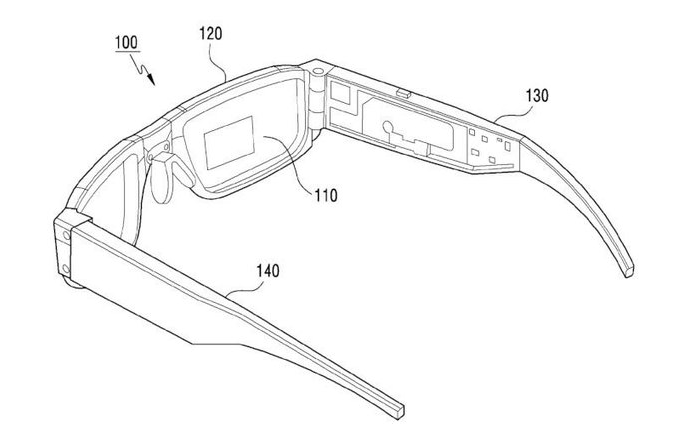Samsung is Building Foldable Augmented Reality Glasses
Samsung’s early efforts at immersive technologies were mainly focused on virtual reality rather than augmented reality platform development. However, the company is just about to branch into AR according to a patent application published this month by the US Patent & Trademark Office. The patent indicates Samsung is currently actively working at developing foldable AR glasses with very thick frames that will accommodate the tech inside.
This will be Samsung’s first foray into augmented reality hardware. It’s still early days as far as the design goes but the patent is showcasing a smart glass that can automatically switch on and off when the glasses are folded or unfolded respectively. This clever design ensures that the glasses will not be running when they aren’t supposed to. When the AR glasses are unfolded (powered on), a small projector installed on the glasses will beam an image on a small display which will then appear in front of one eye of the user.

The glasses have also been designed with magnetic sensors which ensure they remain in the unfolded position during use even if the user performs actions such as turning their heads or where they accidentally get crooked.
This being only a patent, there are no guarantees that the product will eventually see the light of day. Samsung has mentioned the ARM-based processors as one of the main chips in the patent as an illustration of the kind of tech the smartglasses could run on if the concept goes all the way to the shop-floor
Apart from the foldable design, the Samsung smart glasses will have another unique feature. Unlike other augmented reality glasses like the Magic Leap One and the Microsoft HoloLens which will fully wrap around the head like industrial goggles, the Samsung smart glass design resembles plastic sunglasses. Its design is very similar to that of the various Bluetooth audio sunglasses that have been launched in recent years by brands such as Bose and Oakley.
The main difference between the Samsung design and the audio glasses is the small square display which appears in front of at least one of the eyes of the wearer after it has been reflected from a prism and then onto the lens from a tiny temple-mounted projector.
Samsung has suggested that the projector will display a translucent image which will come up on top of the field of vision of the wearer. This design is likely to be based on the use of a waveguide to diffract the projection such that it would bring out the 3D depth.

Users won’t have to rely on a dedicated power button for the projector. Rather, the projector would be automatically powered on when a user opens one of its frames and it would be turned off when the user folds the temple closed. This type of designs help in conserving energy during use thus ensuring the battery lasts longer.
The normal movements of the user’s head have to be factored in which means that there will need to be a mechanism for keeping the projector from the on and off jitters as the frame jostles. In the patent, Samsung has suggested that this could be done through the use of magnetic jitters close to the hinges that will keep the temple position “open”. This will also complete a flexible electrical circuit from the battery of one temple running through the frames and onto the projector in the other temple.
The Samsung patent application also talks about the concept’s display actuating technology. However, Samsung isn’t narrowing options to only one frame shape that it has shown in the images in the patent application or even a single mechanism through which the glasses might work. Instead, the tech giant left the door open to the possibility of the frames being equipped with various kinds of processors ranging from the ARM chips to the more dependent processors with anywhere from a short-range (such as Bluetooth) to a longer-range technology such as wireless transmission.
So there is some flexibility as to what will be under the hood which is often common in patent applications. That kind of latitude leaves the door open for the incorporation of different tech in the future and prevents Samsung’s competitors from stealing its ideas from the patent application and using them on identical devices.
The idea that Samsung is currently exploring possible practical implementations for wearable waveguide displays which could be used specifically for augmented reality glasses is an encouraging one. The patent was filed on January 2, 2019 but was only published yesterday which may be an indication that Samsung is already doing hardware development. Other companies currently working on foldable augmented reality hardware and which may be future Samsung competitors include Nreal and Apple.
https://virtualrealitytimes.com/2019/07/14/samsung-is-building-foldable-augmented-reality-glasses/https://virtualrealitytimes.com/wp-content/uploads/2019/07/Samsung-Smart-Glasses-Market-600x399.jpghttps://virtualrealitytimes.com/wp-content/uploads/2019/07/Samsung-Smart-Glasses-Market-150x90.jpgInventionsSamsung’s early efforts at immersive technologies were mainly focused on virtual reality rather than augmented reality platform development. However, the company is just about to branch into AR according to a patent application published this month by the US Patent & Trademark Office. The patent indicates Samsung is currently...Sam OchanjiSam Ochanji[email protected]EditorVirtual Reality Times - Metaverse & VR
